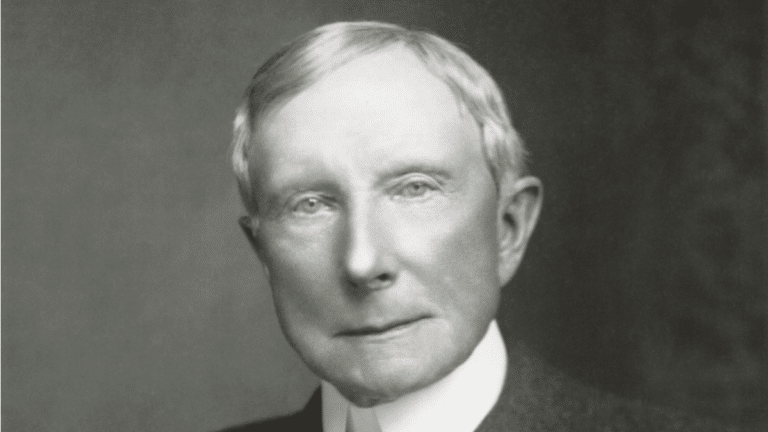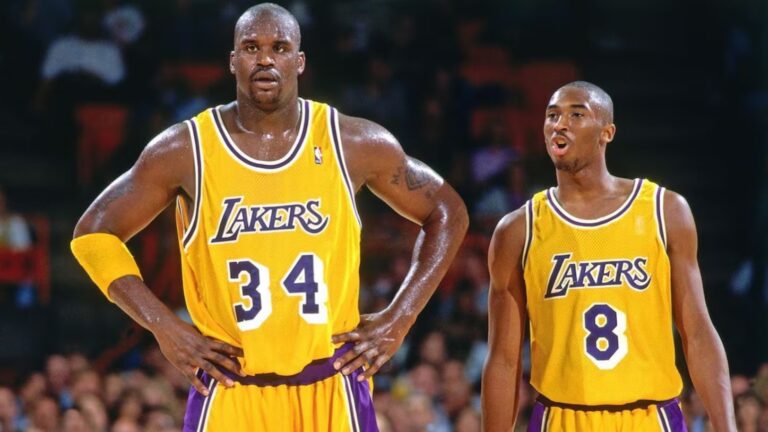John D. Rockefeller Net Worth

John D. Rockefeller holds the esteemed title of being the wealthiest individual in all of history. During his zenith, it is estimated that John D. Rockefeller’s net worth would have reached an astounding $418 billion in 2022, accounting for inflation.
Rockefeller, an American business magnate, philanthropist, and entrepreneur, established the Standard Oil Company in 1870, from which he accumulated the majority of his wealth.
His net worth increased as gasoline and kerosene became more popular during the late 1800s and early 1900s.
This article delves into the remarkable journey of John Rockefeller, who achieved unparalleled wealth during his lifetime. Additionally, we will analyze his net worth in light of inflation, revealing an estimation of his hypothetical fortune in the present day.
Early Life
On July 8th, 1839, John Davison Rockefeller Sr came into the world in Richford, New York. He was the second offspring of Bill Rockefeller and Eliza Davidson.
His mother, Eliza, adhered to the Baptist faith, while his father pursued a career as a businessman and salesman. However, his father’s most distinctive trait was his proficiency as a con artist.
He referred to himself as a “botanic physician,” offering elixirs that claimed to treat various health problems.
Bill lacked a firm moral compass, evident by his infrequent presence with his family and the alleged marriage to another woman while still being married to Rockefellers’ mother.
Growing up, Rockefeller gained valuable insights from both of his parents.
Every opportunity he had, his father would attempt to outsmart Rockefeller, considering it a way to maintain his son’s sharpness. In order to maintain a stable household, his mother instilled in Rockefeller the belief that reckless indulgence only leads to an urgent need for more.
At the age of sixteen, Rockefeller embarked on his initial employment as an assistant bookkeeper, a role that led him to uncover his exceptional talent for accurately computing transportation expenses.
Despite earning no more than $58 per year as a bookkeeper, Rockefeller always had the unwavering belief that he would eventually amass a fortune of $100,000 (which would be equivalent to a staggering $2.74 million in 2022).
Clark & Rockefeller
John D. Rockefeller embarked on a journey into the produce commission business alongside his partner Maurice B. Clark in 1859, when he was just 20 years old.
Clark & Rockefeller made $4,400 in their inaugural year of business. In the subsequent year, their net income skyrocketed, almost quadrupling to $17,000 (equivalent to $530,688 in 2022).
Following the onset of the American Civil War, the demand for food supplies surged, resulting in a significant boost in their profits.
As the Civil War was nearing its end and war-related earnings were diminishing, Clark & Rockefeller shifted their attention to the refinement of crude oil.
Oil Industry
The oil industry prior to John D. Rockefeller’s involvement was characterized by significant disarray, as small-scale oil refiners would purchase crude oil directly from producers and subsequently sell it to manufacturers of kerosene lamps.
The absence of any standardization in the quality or price of crude oil or kerosene resulted in substantial fluctuations in profitability for all parties involved.
Rockefeller and a handful of investors acquired multiple small oil refineries in Cleveland, Ohio, aiming to boost profits and bring stability to the industry. These refineries were merged into a single entity known as the Standard Oil Company.
Standard Oil Company

In addition, John D. Rockefeller recognized the emergence of a potential market for refined oil, specifically in the form of kerosene. Prior to this, the extraction of kerosene relied on coal, which proved to be an inefficient method.
Despite its inefficiencies, the current mark-up on refined oil ranged from 62% to 160%, which motivated him to establish his own company, Standard Oil Co in 1870.
Numerous individuals ventured to amass wealth by speculating in oil, yet the majority were not able to achieve success.
The primary reason for this was the practice followed by the majority of refineries, wherein they would retain 60% of oil product as kerosene while disposing of the remaining 40% in rivers and large sludge piles.
Rockefeller skillfully evaded wastage by marketing it as lubricating oil, petroleum jelly, paraffin wax, tar, and various other by-products.
By swiftly acquiring the least efficient competing refiners, enhancing its operations, securing bulk discounts on oil shipments, reducing prices, and increasing investment pools, Rockefeller rapidly expanded the company.
Rockefeller swiftly rose to prominence in the industry by procuring an inefficient oil refinery and providing subsidies for oil prices, allowing him to gain valuable insights from his rivals’ errors and establish himself as the foremost leader.
Standard Oil, by 1872, had acquired 22 out of the 26 rival companies in Cleveland, Ohio. Not only was it obtaining its competitors, but it also gained control over the entire supply chain.
It incorporated its own pipelines, tank cars, and established a home delivery network.
Due to their high oil production, they managed to maintain low prices, discouraging competitors and ensuring affordability for the average consumer.
At the close of the 1870s, Standard Oil had successfully refined more than 90% of the oil produced in the United States, consequently propelling Rockefeller into the realm of multi-millionaires.
Monopoly
Due to Rockefeller’s overwhelming control of more than 90% of the oil industry, Standard Oil faced continuous criticism from journalists, politicians, and even the federal government, who accused the company of engaging in unfair monopolistic practices.
The passing of Antitrust laws and the establishment of the Federal Trade Commission (FTC) were direct consequences of unjust practices such as these. At the age of 63, he retired in 1902.
Dissolution of Standard Oil Company
By the 1890s, there was a growing discontent among the public towards corporations such as the Standard Oil monopoly.
The dissolution of Standard Oil Company was ordered by the U.S. Supreme Court in 1911 due to its violation of the Sherman Antitrust Act.
The company underwent a division, resulting in the establishment of 34 distinct entities, which include:
- ExxonMobil
- Chevron
- BP
- Shell
- ConocoPhillips
These companies continue to be among the biggest oil companies globally.
John D. Rockefeller’s Children
John D. Rockefeller entered into matrimony with Laura Spelman in 1864, resulting in the birth of four daughters and one son.
The Rockefeller family holds an esteemed position as one of the world’s wealthiest and most influential families. John D. Rockefeller, who established Standard Oil, emerged as one of America’s earliest self-made billionaires.
John D. Rockefeller Jr., the son of John D. Rockefeller, achieved remarkable success as both a businessman and philanthropist. One of his notable contributions was the establishment of the renowned Rockefeller Center located in New York City.
In addition to that, he was the architect responsible for the creation of Radio City Music Hall as well as the American Museum of Natural History.
David, the son of John Jr., pursued a career in politics and diplomacy. He held esteemed positions such as the Governor of New York and the U.S. Deputy Secretary of Defense.
Even in present times, the Rockefeller family continues to possess immense wealth and wield significant influence. Their vast fortune encompasses businesses, properties, and art collections valued in the billions of dollars.
For many years, the family has actively engaged in philanthropic endeavors, generously contributing funds to various causes, including education, healthcare, and environmental preservation.
David Rockefeller’s Net Worth
David Rockefeller, the youngest son of John D. Rockefeller Jr., held the position of chairman and CEO at Chase Manhattan (currently part of JP Morgan Chase).
David Rockefeller, the senior member of the third generation of the Rockefeller family, held the distinction of being the oldest living member.
From August 2004 until his passing in March 2017, he served as the family patriarch for a span of 13 years.
He possessed extensive political affiliations and frequently embarked on journeys.
At the time of his demise in March 2017, David Rockefeller’s estimated personal fortune stood at $3.3 billion.
Philanthropy of the Rockefeller Family
Over the years, the Rockefeller family has established a remarkable legacy in the field of philanthropy. An illustration of their generosity can be traced back to 1902 when Rockefeller contributed a staggering $1,000,000 to establish the General Education Board. Additionally, the family has extended their support to various other causes throughout their history.
The Rockefeller Foundation

Established by John D. Rockefeller in 1913, the Rockefeller Foundation is a non-profit entity with a noble objective of advancing the overall welfare of humanity on a global scale.
The foundation has provided financial contributions to various causes including education, healthcare, environmental preservation, and poverty alleviation.
The foundation has undertaken several remarkable initiatives, including the Green Revolution aimed at enhancing crop yields to combat hunger, the development of the polio vaccine, and the provision of assistance to small businesses in developing nations.
With assets exceeding $3 billion, the Rockefeller Foundation stands as a prominent global philanthropic organization. Yearly, it generously donates millions of dollars to various causes.
The Rockefeller University

In 1901, John D. Rockefeller established the Rockefeller University, also referred to as the Rockefeller Institute, as a private research university situated in New York City.
The university’s primary focus lies in the exploration of medical research within the fields of life sciences, medicine, and biotechnology. It proudly holds a distinguished reputation as one of the most esteemed research institutions globally.
There have been 12 Nobel laureates and 27 National Medal of Science winners who have emerged from the university.
Atlanta Baptist Female Seminary

John D. Rockefeller and his wife, Laura Spelman Rockefeller, established the Atlanta Baptist Female Seminary (now known as Spelman College) in 1881.
One of the pioneering educational institutions in the United States for African-American women was the seminary.
Spelman College, currently acclaimed as one of the nation’s premier historically black colleges, boasts a remarkable endowment exceeding $400 million. Moreover, it generously awards scholarships to a yearly cohort of over 2,000 students.
Over the years, the Rockefeller family has generously given millions of dollars to Spelman College. In 2018, an unprecedented $50 million donation was bestowed upon the school, marking the most substantial contribution in its history.
It came as no surprise, considering the Rockefeller family’s well-known support for abolitionism.
John D. Rockefeller Sr. actively participated in the Underground Railroad, a clandestine network dedicated to aiding slaves in their escape to freedom.
The Rockefellers additionally contributed funds to back abolitionist endeavors, including the American Anti-Slavery Society.
The Metropolitan Museum of Art

Founded in 1870 by John D. Rockefeller, the Metropolitan Museum of Art in New York City stands as a colossal and highly influential institution, ranking among the largest museums worldwide.
The museum’s collection comprises more than two million works of art, spanning from ancient Egyptian artifacts to contemporary paintings.
John D Rockefeller Net Worth 2023
What would be the current net worth of John D. Rockefeller? During his complete retirement at 63 years old, Rockefeller accumulated over $58 million in investments in 1902 (equivalent to just over $1.7 billion dollars in 2022).
In 1913, during his prime, John D. Rockefeller possessed an approximate net worth of $418 billion dollars, which, when adjusted for inflation in 2022, remains an astounding figure.
In 1913, Rockefeller possessed a fortune of approximately $900 million, constituting nearly 3% of the United States’ GDP during that period.
The Rockefeller fortune is currently valued at approximately $8.4 billion dollars, positioning them among the wealthiest families globally.
Key Takeaways
After discovering the present net worth of John D Rockefeller, let’s delve into some valuable lessons we can learn from his remarkable career.
You Can Pave Your Own Destiny
Despite being born to a well-known con artist, John D. Rockefeller chose to diverge from a potential similar fate and instead embraced a strong moral compass, making the decision to marry only once.
Our family is not within our control, but our destiny is completely in our hands.
There Is Never a Lack of Resources, Just Resourcefulness
Due to the requirement of discarding 40% of the materials they would extract, numerous entrepreneurs missed out on capitalizing on the expanding oil market.
Rockefeller made the decision to sell the perceived waste to companies in need, rather than letting this 40% go to waste.
Spot Opportunity and Take Action
Similar to how Mr. Wonderful foresaw the rapid growth of computers and software as a lucrative industry in the 1990s, Rockefeller anticipated the explosive success of refined oil in the form of kerosene as it entered the 1900s.
Rockefeller, lacking any prior knowledge in oil manufacturing, ventured into starting Standard Oil. Like many entrepreneurs, he believed in learning through action rather than intensive studying.
Had Rockefeller postponed his start in the oil industry to gather more knowledge, there was a chance he could have missed out on his opportunity.














